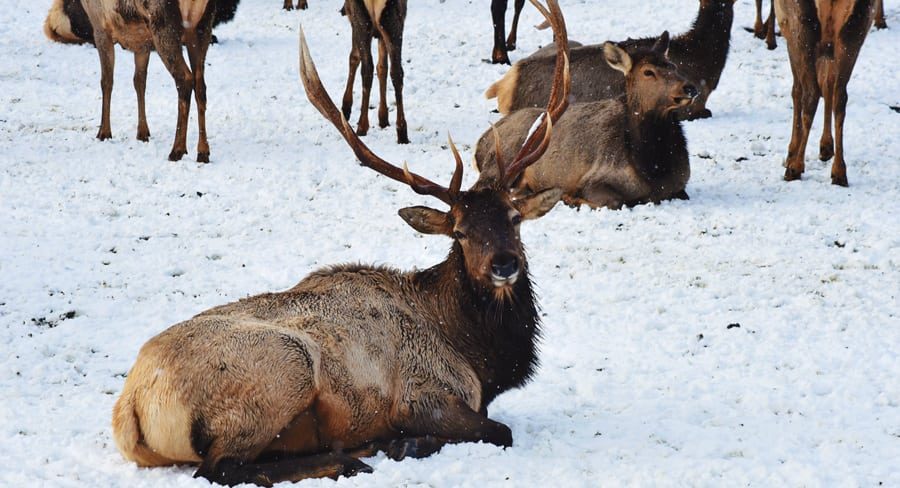
Home » Get close up view of wintering elk at the Oak Creek Wildlife Area
Get close up view of wintering elk at the Oak Creek Wildlife Area

February 18, 2016
On an overcast snow-covered day, a large herd of elk herd plows over the ridge and gathers aside a gated fence just below the hills near Naches. They form in tight huddles, waiting for flakes of hay to be spread for them across the white-blanketed Oak Creek Wildlife Area each afternoon.
Nearly 10,000 visitors come every year from across the Pacific Northwest and beyond to observe the supplemental winter-feeding of Rocky Mountain Elk – up to 1,200 elk, including 90 bulls, sporting impressive wide-branched antlers.
The elk are fed daily at 1:30 p.m. at the Oak Creek Visitor Center. The elk begin arriving in mid-November annually and stay in the area until March. January and February are the best months for viewing, as deep snow blankets larger areas where they graze, making it harder for them to find food in the higher elevations. You can see cows, bulls, and calves.
A large parking lot and viewing area allows the public to observe the elk as they feed.
The visitor center is open from 9 a.m. to 4 p.m. during the winter months and is staffed by volunteers. A Discover Pass or Vehicle Access Pass is required to access Oak Creek Wildlife area. The visitor center has exhibits, information and a kids’ corner.
The staff at the Oak Creek offers truck tours, taking visitors for a close-up view of the elk as they feed. Tours are offered on both a first-come, first-served and reservation basis. The tours are supported by participant donations, which are used to take care of the elk, equipment and maintenance.
“This is one of the only places in the country where you can park your vehicle and get out and see them up close,” said Ross Huffman, manager at the wildlife area. “We do tours where people can get on military trucks and see them out in the wild. The tour guides give you history and answer questions. It truly is a special opportunity.”
The Rocky Mountain elk are not native to the area. They were brought to the Yakima Valley from Montana in 1913 by a group of sportsmen, landowners and Yakima County officials who wanted game to hunt.
Rocky Mountain elk are migratory animals, and during winter the herd travels from higher elevations in the Cascade Mountains to the lower elevations of the Yakima Valley in the winter to forage for food.
“Annual feeding didn’t start till the 60s,” said Huffman.
Prior to that, the elk were fed only in truly bad winters. Fences were put up to keep the elk from wandering through the valley and getting into barns and haystacks and damaging crops, he added.
The elk are herbivores, grazing on trees, shrubs, flowering plants, and grasses. When food is scarce in the winter, elk can be found foraging in farm fields and orchards. Here, they come into conflict with farmer and ranchers whose orchards occupy land the elk need for wintering. It is the reason the fence and the feeding program was established.
The 64,200-acre Oak Creek Unit is 15 miles northwest of Yakima.
The State of Washington Department of Fish and Wildlife manages this sparsely timbered area in the grassy foothills.
In the mid-1940s, the Department of Fish and Wildlife began building almost 120 miles of 8-foot-high fences to keep the elk from damaging private property.
The feed trucks drop hay every 10 to 20 feet and when the elk are feeding volunteers count the number of elk. Wintering elk may eat from three to 10 pounds of hay each day at the feeding stations. Elk begin arriving as early as mid-November, with the largest part of the herd arriving when winter progresses and snow blankets the hills.
“The fence was put up in the 40s to provide a safe place for the elks,” said Huffman. “This area is managed for recreation, hunting, camping, and wildlife habitat preservation.”
The trip is a special opportunity to learn more about land management, big game hunting, wildlife preservation, and the area’s history. Oak Creek Headquarters is two miles west of the junction of Highway 12 and 410 on Highway 12. You can also visit the bighorn sheep-feeding site near the junction, off 410 on Old Naches Highway. The Bighorn Sheep are fed mid-morning.
Call the Oak Creek Wildlife area at 509-653-2390 for more information on wintering wildlife. To make a reservation for the truck tours call 509-698-5106. For more information, go to wdfw.wa.gov/lands/wildlife_areas/oak_creek/.
Local News
KEYWORDS day trip february 2016




